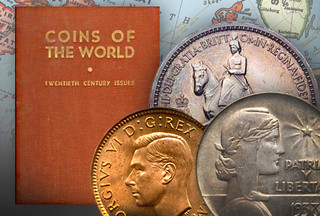
PREV ARTICLE
NEXT ARTICLE
FULL ISSUE
PREV FULL ISSUE
BOOK REVIEW: RAYMOND’S COINS OF THE WORLD
This isn't a new book, but an important one in the development of the hobby.
David Alexander wrote about Wayte Raymond’s Coins of the World in a September 18, 2014 CoinWeek article. Here's an excerpt.
-Editor
He demanded order in his world coin listings and exercised great care to include only coins struck for circulation by legitimate governments. Proofs were not listed separately and coins generally appeared in chronological order of issue. Coins of monarchies, such as British and British Empire, were broken down by ruler. First issues of George V from 1911-1927 were distinct from second reverse coins 1927-1936, but the debased silver of 1921 onward was not listed separately. Metal order was Gold, Silver, Bronze, with newer alloys such as Copper-nickel or Nickel-brass appearing in their denominational position. Raymond presented the highest denominations first, followed by the rest in descending order, in the British case Crown, Half Crown, Florin, Shilling, Sixpence, Threepence, Penny, Halfpenny, Farthing. Dates were presented in ranges, such as 1937-1948, which did not mean that all years in between were actually struck. A single catalog price was given for the most common date of each type, in Uncirculated for most modern dates, “at least Very Fine” for older pieces. Remember, virtually no one collected world coins by date in the 1950’s, and Raymond paid little attention to Mint marks. Coins were illustrated by halftones grouped on plate pages, (which caused havoc among fast-evolving Chinese listings) or dropped into the text. Photos illustrated basic types, and many coins photographed came from the ANS collection, such as the Somalia base silver one Somalo with its distinctive fingerprint on the reverse. Hard covers, high quality glossy stock and elegant typography made all editions of Coins of the World durable and attractive. Raymond never asserted that his work was perfect. Exceedingly slow to make changes, he delayed correcting errors even when these were respectfully pointed out by experts such as Dr. Imre Molnar, who noted the anachronistic 1955 description of Hungary as “bounded on the west by Germany” as it had been in 1938-1945. Pricing was a source of debate and new additions were seldom priced at all as Raymond believed time had to pass to allow the emergence of realistic pricing. World War II listings for countries like Slovakia included many errors such as metals that were never used, and these remained chaotic until the end. Nevertheless, Coins of the World really established the path for modern world collecting and was a gigantic step forward little appreciated today. Wayte Raymond died on Sept. 23, 1956 and most of his publications ceased or were purchased by others. Veteran dealer John J. Ford Jr. wrote a five-page appreciation for the February 1957 issue of The Numismatist, “ Wayte Raymond: the Man and his Era” the only obituary ever to win the ANA’s highest literary award.
David's article opens with a reminiscence of his days as a young numismatist in Miami and the Miami Coin Club. Be sure to check it out.
-Editor
To read the complete article, see:
The Numismatic Bibliomania Society is a non-profit organization promoting numismatic literature. See our web site at coinbooks.org. To submit items for publication in The E-Sylum, write to the Editor at this address: whomren@gmail.com To subscribe go to: https://my.binhost.com/lists/listinfo/esylum All Rights Reserved. NBS Home Page Contact the NBS webmaster 
|
